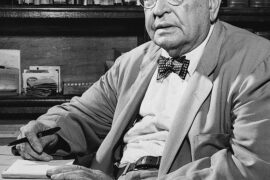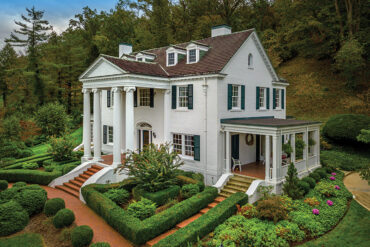By James E. Casto
HQ 64 | WINTER 2008
It’s New Year’s Eve 1947 – and the end of a colorful era. The last night of the year brings the final run of the “Paul F. Thomas,” the only remaining ferryboat in service in the Huntington area.
Gently the little boat rocks back and forth on the water as a few cars make their way down the roadway, up the ramp and onto the deck of the waiting ferry. Their gleaming headlights point the way. With the last of the cars safely stowed aboard, the command to “Cast Off!’ comes from the wheelhouse and the lines holding the boat snug to the shore are let go. Slowly the ferry pulls away from the bank, aiming for the opposite shore of the Ohio River.
The crossing is leisurely, the conversation between the passengers mostly quiet and hushed. Perhaps there’s a bit of laughter. After all, it’s New Year’s Eve. No doubt some of the passengers are in their party-going clothes.
The lapping of the river against the sides of the ferry is more felt than heard. The trip across the river takes only a few minutes. Soon the opposite bank looms in the mist ahead. The captain carefully pilots the boat to the dock, the lines are made fast, the ramp lowered. The engines of the automobiles cough to life and they make their way ashore, in a lighted orderly procession.
The “Paul F. Thomas” has made its last trip.
Long before Collis P. Huntington dreamed of building the city that would carry his name, ferryboats regularly crossed the Ohio at the city’s future site. As the rail tycoon’s new city grew, the area’s ferry operators prospered.
Even after the old Sixth Street Bridge opened in 1926, river ferries continued operating. Many Ohio farmers relied on the ferries to get their produce to Huntington’s City Market for sale. Long before dawn they could be seen lining up their trucks and wagons so they could catch the first morning ferry across the Ohio. The farmers preferred the ferry over the bridge because, while both charged a toll, bypassing the bridge also meant bypassing the rough roads leading to it.
Thomas Buffington, one of the area’s pioneer residents, is thought to have received a license to operate a ferry service across the Guyandotte River around 1802.
But according to an article in “Cabell County Heritage, 1809-1996,” the region’s first Ohio River ferry license – one for ser vice between Proctor ville, Ohio, and Guyandotte — was granted to Abraham Miller in 1823. Guyandotte, of course, was then still part of Virginia.
In 1835, Abner Smith was granted a Proctorville-Guyandotte ferry license. In 1862, in the midst of the Civil War, Smith’s son-in-law, Charles E. Watters, was operating the family ferryboat when he was captured by Confederate troops. He was later released.
Abner Smith and his wife Elizabeth had a son, William, who married Sarah Bay, whose brothers operated a sizeable fleet of Ohio River packet boats. In 1878, William and Sarah Bay Smith started their own Proctorville-Guyandotte ferry business. Sarah would go on to become the first woman pilot on the upper Ohio. William and Sarah’s sons, George and Edward, took over the ferry service after the death of their parents.
In 1912, a brother-in-law, Paul F. Thomas, bought a half interest in the Smith brothers’ ferry. Five years later, in 1917, he sold his interest and formed the 26th Street Ferry Company, which connected Bradrick, Ohio, and 26th Street in Huntington.
The Proctorville-Guyandotte ferry remained in business, operating a series of boats over the years. Its last boat, the “Champion No. 3,” was in service from 1929 until 1935, when the ferry was discontinued.
In 1918, Ben T. Flesher brought a rebuilt boat to Huntington and used it to establish a ferry service linking Chesapeake and the river landing at the foot of 10th Street in Huntington. The craft had been named the “New Pike” when she was built at the Howard Shipyards in Madison, Indiana, in 1877. Flesher re-christened her the “City of Huntington.”
Flesher operated the “City of Huntington” for several years, and on his death his son-in-law, Robert Hamilton, continued to run it. The boat made her last run in 1936. According to an article in the 1959 Sesquicentennial Edition of The Herald Dispatch and The Advertiser, she sank in ice in the mouth of Symmes Creek on the Ohio side of the river.
Old-time Huntingtonians also recall that a ferryboat once ran from Hull’s Landing at the foot of West 14th Street, serving businesses and residents in Central City, but details of its operation have been lost in the mists of time.
The 26th Street Ferry Company started service with a secondhand boat but in 1921 constructed a new boat on the riverbank in Huntington. The new boat was named “Oweva,” a name representing Ohio and West Virginia. In her article in “Cabell County Heritage,” Margery Thomas Burcham, granddaughter of Paul F. Thomas, wrote that a contest was conducted to name the new boat and a man was awarded $10 for coming up with the winning name. The “Oweva” ran until 1935, when her machinery and boilers were moved to a new boat, the “Paul F. Thomas.”
The “Paul F. Thomas,” built by the Howard Shipyards, was said to be the largest and fastest sternwheeler ferry ever to operate on the Ohio. She could travel upstream, bucking the current, at 10 to 12 miles per hour, even with a full load of cars. On a busy day, she could haul as many as 1,800 cars across the river.
In times of high water – and especially during the devastating 1937 flood – the 26th Street Ferry was invaluable, taking milk, bread, mail, newspapers and even doctors to the flooded Proctorville area and carrying workers, mail and raw milk back to Huntington.
Originally, the Ohio River ferryboats ran from roughly daylight to dark. Thomas star ted 18-hour service and later extended that to 24 hours. The longer hours eliminated the long lines of cars and trucks that sometimes waited to board – and meant that farmers no longer had to worry about getting to the landing in time for the first ferry of the day.
Business was good – so good that the company had a second boat built, the “Rosemary,” named for Paul F. Thomas’s eldest granddaughter. Built by the Marietta Manufacturing Company in Point Pleasant, the “Rosemary” was a bit smaller than the “Paul F. Thomas,” carrying only 18 cars compared with the 25 that could be loaded aboard the older boat. She was in service from 1939 to 1943, when she was sold to a new owner in Kentucky.
In December 1947, Paul F. Thomas decided to retire. He had been on the river for 50 years and had been operating the 26th Street Ferry since 1917. His namesake boat had been damaged due to ice in the river, thus it seemed an appropriate time to call it quits. And so the “Paul F. Thomas” was dismantled. Her engines and whistle are now at the Ohio River Museum in Marietta, Ohio.
The era of Huntington ferryboats was ended.





